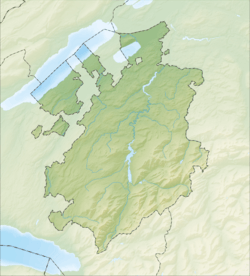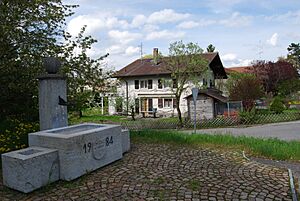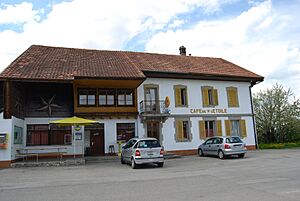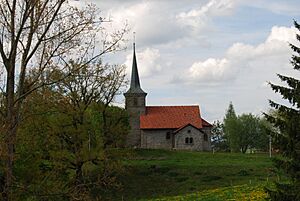Le Glèbe facts for kids
Quick facts for kids
Le Glèbe
|
||
|---|---|---|
 |
||
|
||
| Country | Switzerland | |
| Canton | Fribourg | |
| District | Sarine | |
| Area | ||
| • Total | 10.31 km2 (3.98 sq mi) | |
| Population
(Dec 2014)
|
||
| • Total | 1,246 | |
| • Density | 120.85/km2 (313.01/sq mi) | |
| Postal code |
1695
|
|
| Surrounded by | Autigny, Farvagny, Pont-en-Ogoz, Sorens, Villorsonnens, Vuisternens-en-Ogoz | |
Le Glèbe (French: [lə ɡlɛb]; Arpitan: Le Gllèbe) was a small town, also called a municipality, located in the Fribourg area of Switzerland. It was formed on January 1, 2003, when four smaller villages – Estavayer-le-Gibloux, Rueyres-Saint-Laurent, Villarlod, and Villarsel-le-Gibloux – joined together. Later, on January 1, 2016, Le Glèbe became part of a new, larger municipality called Gibloux, merging with other towns like Corpataux-Magnedens and Farvagny.
Contents
Exploring Le Glèbe's Geography
Le Glèbe covered an area of about 10.4 square kilometers (4 square miles) as of 2009. A large part of this land, about 72.3%, was used for farming. This means fields for crops and pastures for animals.
About 18.9% of the area was covered by forests. The remaining 8.2% was developed land, meaning it had buildings or roads. Most of the developed land was used for houses and other buildings.
People and Population
In 2014, Le Glèbe had a population of 1,246 people. Over ten years, from 2000 to 2010, the number of people living there grew by 23.5%. This growth was mostly because new people moved into the area.
Most people in Le Glèbe speak French. In 2000, about 94.7% of the population spoke French as their main language. A small number of people spoke German or Portuguese.
In 2008, the population was almost evenly split between males and females. About 51.4% were male and 48.6% were female. Most residents were Swiss citizens.
Many people living in Le Glèbe in 2000 were born there or in the same canton (region). About 30.4% of the population were children and teenagers (0-19 years old). Adults (20-64 years old) made up 58.7%, and seniors (over 64 years old) were 11%.
The chart below shows how the population of Le Glèbe changed over many years:

Economy and Jobs
In 2010, the unemployment rate in Le Glèbe was very low, at 1.3%. This means most people who wanted to work had jobs.
Jobs in Le Glèbe were divided into three main types:
- Primary Sector: This includes jobs related to getting raw materials, like farming. In 2008, about 76 people worked in this area, mostly in agriculture.
- Secondary Sector: These jobs involve making things, like in factories or construction. About 76 people worked in this sector, with many in construction.
- Tertiary Sector: This covers service jobs, like working in shops, restaurants, or schools. Around 59 people worked in this sector.
Many people who lived in Le Glèbe traveled to other towns for work. In 2000, about 75.9% of working residents used a private car to get to their jobs.
Religion in Le Glèbe
According to the 2000 census, most people in Le Glèbe were Roman Catholic, making up about 90.5% of the population. A small number of people belonged to the Swiss Reformed Church or other Christian groups. About 8% of the population did not belong to any church.
Education System
In Switzerland, the education system is well-structured. In the Canton of Fribourg, where Le Glèbe is located, children usually start with one year of non-required Kindergarten. After that, they attend six years of Primary school.
Next comes three years of required lower Secondary school. Here, students might be grouped based on their abilities. After this, students can choose to go to an optional upper Secondary school for three or four years. This can be a gymnasium (which prepares students for university) or a vocational program (which teaches skills for a specific job). After upper Secondary, students can go to a higher education school or start an apprenticeship.
During the 2010-2011 school year, Le Glèbe had 126 students in 7 classes. While some students attended school within Le Glèbe, many also traveled to neighboring towns for their education, especially for secondary and higher education.
Images for kids
See also
 In Spanish: Le Glèbe para niños
In Spanish: Le Glèbe para niños








